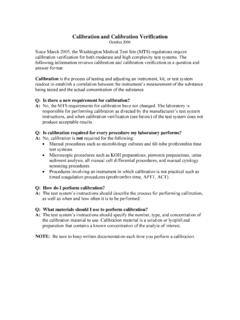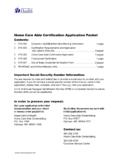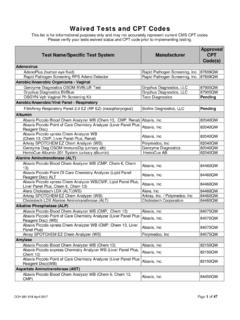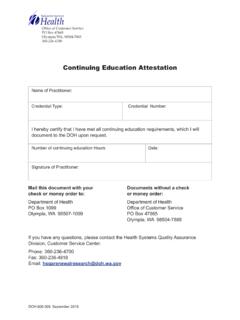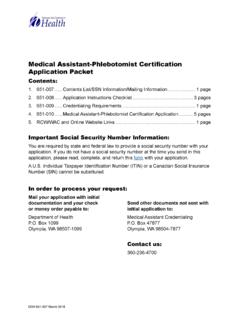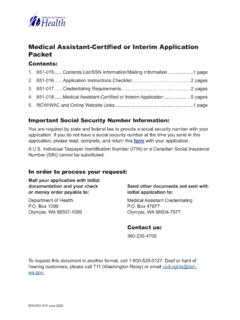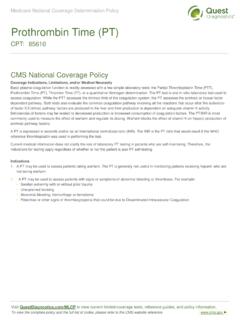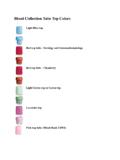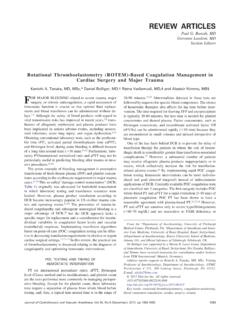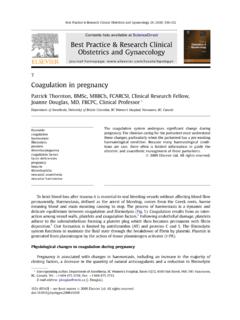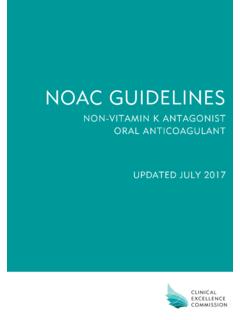Transcription of Trauma Clinical Guideline Head Injury in Anticoagulated ...
1 DOH 689-160 October 2019 Washington State Department of Health Office of Community Health Systems Emergency Medical Services & Trauma Section Trauma Clinical Guideline Head Injury in Anticoagulated Patients The Trauma Medical Directors and Program Managers Workgroup is an open forum for designated Trauma services in Washington state to share ideas and concerns about providing Trauma care. The workgroup meets regularly to encourage communication among services, and to share best practices and information to improve quality of care. On occasion, at the request of the Emergency Medical Services and Trauma Care Steering Committee, the group discusses the value of specific Clinical management guidelines for Trauma care. The Washington State Department of Health distributes this Head Injury in Anticoagulated Patients Trauma Care Guideline on behalf of the Emergency Medical Services and Trauma Care Steering Committee.
2 The goal is to assist Trauma care services with developing their Trauma patient care guidelines. Toward this goal the workgroup has categorized the type of Guideline , the sponsoring organization, how it was developed, and whether it has been tested or validated. The intent of this information is to assist physicians in evaluating the content of this Guideline and its potential benefits for their practice or any particular patient. The Department of Health does not mandate the use of this Guideline . The department recognizes the varying resources of different services, and that approaches that work for one Trauma service may not be suitable for others. The decision to use this Guideline depends on the independent medical judgment of the physician. We recommend that Trauma services and physicians who choose to use this Guideline consult with the department regularly for any updates to its content.
3 The department appreciates receiving any information regarding practitioners experience with this Guideline . Please direct comments to 360-236-2874. This is a Trauma assessment and management Guideline . It was adapted from professional literature. The workgroup reviewed the Guideline , sought input from Trauma care physicians throughout Washington state, and used that input to make changes. Both the Emergency Medical Services and Trauma Care Steering Committee and the Department of Health Office of Community Health Systems endorsed the Guideline . This Guideline has not been tested or validated. Washington State Department of Health Office of Community Health Systems 111 Israel Road Box 47853 Olympia, WA 98504-7853 Phone 360-236-2800 Website: DOH 689-160 October 2019 Head Injury in Anticoagulated Patients Background: Chronic anticoagulation therapy is used in managing a variety of Clinical conditions including prosthetic heart valves, chronic atrial fibrillation, pulmonary embolus, deep vein thrombosis, and procoagulant states.
4 Warfarin is the most common oral anticoagulant used for chronic anticoagulation therapy, and an increasing number of elderly patients taking warfarin are being seen as Trauma patients. Use of warfarin is a significant predictor of mortality in patients with traumatic intracranial hemorrhage. A significant number of patients initially present with no or minimal neurological symptoms and minor intracranial hemorrhage that progress to a moribund and ultimately fatal hemorrhage while awaiting diagnosis and initiation of treatment. Rapid confirmation of intracranial hemorrhage with expedited head computed tomography (CT) scan combined with prompt reversal of warfarin anticoagulation may decrease progression of intracranial hemorrhage and reduce mortality. Goal: To rapidly identify intracranial hemorrhage in Anticoagulated patients and reduce the time from presentation to reversal of anticoagulation.
5 PROTOCOL: 1. Inclusion criteria: The protocol applies to all adult (18 or older) warfarin and dabigatran Anticoagulated Trauma patients, deemed at risk for intracranial Injury . This includes all warfarin and dabigatran Anticoagulated patients with blunt mechanisms of Trauma , including falls from same level (ground-level fall), who have one of the following: Any loss of consciousness after Trauma . Any mental status changes after Trauma . History of direct impact to the head or neck. Any signs of external Injury to head or neck such as abrasion or ecchymosis. Falls from one level to another level. 2. Exclusion Criteria: Hospice patients. Patients who are part of the Trauma code, hemodynamically unstable, or displaying signs of hemorrhagic shock that may need other life-sustaining procedures. As part of their resuscitation, these patients may need reversal of anticoagulation and may also benefit from prothrombin complex concentrate (PCC) and Idarucizumab (praxbind) (at the direction of the treating physician (for dosing please refer to KCentra table below) 3.)
6 Diagnosis: Rapid triage directly to a treatment area. Stat labs with coagulation screen including Prothrombin time (PT) and international normalized ratio (INR), and type and screen done within 10 minutes of arrival. Emergent ordering of head CT scan. An initial emergent evaluation by emergency physician, Trauma surgeon, or neurosurgeon. Immediate head CT interpretation by the radiologist and communication to treating physician. 4. Treatment Patients without any signs of intracranial hemorrhage on the initial head CT scan are managed based on specific guidelines and/or treating physician discretion, which may include admission for observation or repeat head CT. DOH 689-160 October 2019 Patients with CT scan confirmation of intracranial hemorrhage and INR greater than , please give 10 mg of vitamin K given IV piggyback (Patients with history of allergic reaction to vitamin K will not receive it).
7 Vitamin K Antagonists Pathway A Prothrombin Complex Concentrate (PCC) four-factor is the preferred reversal agent in treating patients who are Anticoagulated with warfarin and have intracranial hemorrhage. Relative contraindications to PCC use include: History of thrombotic or thromboembolic event in past six weeks (DVT, PE, ischemic stroke, acute coronary syndrome, acute venous/arterial ischemia, etc.). Known prothrombotic condition (malignancy, DIC, hypercoagulable condition, hepatic disease, polytrauma, HIT, etc.). If any of the above criteria is met or the patient has mechanical heart valve such as aortic or mitral valve replacement, please discuss with ER, Trauma surgery, or neurosurgery attending the possibility of giving PCC. A four-factor PCC should be able to reverse warfarin anticoagulation without fresh frozen plasma (FFP) administration; therefore, side effects of FFP administration, such as risk for volume overload, may be avoided.
8 However, Trauma patients who require fluid resuscitation may benefit from the combined treatment of PCC with administration of two to four units of FFP as the initial treatment. Combined initial treatment (PCC with FFP) can be initiated at the discretion of the treating physician. If INR , PCC may be considered as described above. Given the scarce evidence and the potential prothrombotic risk of PCC, FFP may be considered as an alternative (see FFP pathway below). Check PT/INR (or EHP) at one hour, six hours and 24 hours after PCC administration. If PT/INR is still greater than after appropriate dosing of PCC in one hour, consider other possible causes such as a low fibrinogen. For patients whose INR does not correct after PCC, please switch to FFP pathway with the empiric administration of two to four units of thawed FFP. A three-factor PCC is also available and a viable option but the addition of one unit of fresh frozen plasma should be administered to aid in coagulation .
9 FFP alone pathway (If PCC not available or decision was made not to use it) Immediately transfuse four units universal-donor FFP and request four units of type-specific FFP to be sent as soon as possible. Check INR after the first four units of FFP have been infused and follow your hospital guidelines or treating physician discretion for repeat FFP dosing as needed. Please note: Appropriate surgical consultation, including neurosurgical consultation, should be obtained emergently. This protocol focuses on the initial rapid process to correct the warfarin-associated anticoagulation in patients with head Injury . Any additional blood product transfusion or patient monitoring is based on hospital guidelines and treating physician discretion. The appropriate treatment of Trauma patients based on Trauma guidelines and advanced Trauma life support (ATLS) supersedes this protocol.
10 As such, at the discretion of the treating physicians, life-saving maneuvers, such as endotracheal intubation, and other required treatments, including transfer to a definitive-care site, should not be delayed. DOH 689-160 October 2019 Direct Thrombin Inhibitor Pathway Patients Anticoagulated with dabigatran (Pradaxa) can safely be reversed with idarucizumab (Praxbind). The FDA recently approved Praxbind for reversal of anticoagulation. The recommended dose for Praxbind is five grams, provided in two separate 50 milliliter vials. Follow the manufacture recommendations. Following the administration of Praxbind a follow-up CT scan should be performed. Factor Xa Inhibitor Pathway Anticoagulation with Factor Xa Inhibitors such as apixaban (Eliquis) and rivaroxaban (Xarelto) can be reversed with Andexanet (ANDEXXA). ANDEXXA was recently approved by the FDA for the reversal of Factor Xa Inhibitors.
